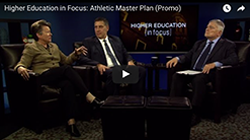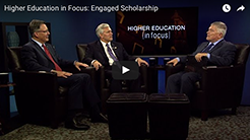This week, President Barron is turning over his blog to Nick Jones, Penn State’s executive vice president and provost. With the recent announcement of a commitment to a 3 percent increase in stipends for graduate assistants at Penn State, Jones revisits a presentation he gave to the Penn State Board of Trustees in January 2015. In this blog, Provost Jones expands on the significance of studying at a research university and the value of graduate students who are part of Penn State’s teaching, research and outreach enterprise.
With a research expenditure budget of over $800 million for the last fiscal year, Penn State is one of the top 20 research universities in the U.S. I reported this, along with many highlights and successes of research and graduate education at the University, to the Board of Trustees in January 2015. With the news of the commitment to a 3 percent stipend increase, I am pleased to see the progress the University is making as part of its continued support of graduate education. Graduate education is a pillar of Penn State’s research enterprise.
Researchers at Penn State are working to solve serious societal problems, and graduate students are an important part of that innovation and discovery. Training Ph.D. students is a core function of any research university. Top-caliber research universities like Penn State equip graduate students to address complex problems, and those students go on to make important research discoveries, become industry leaders and join the professorate at other research institutions.
When one considers the number of research doctorates conferred each year, Penn State consistently ranks in the top 15 of institutions nationally. According to the most recent release of the Survey of Earned Doctorates by the National Science Foundation (December 2014), Penn State places 12th overall in the number of Ph.D. recipients, 6th in the physical sciences, 9th in education, 13th in engineering, and 15th in both life sciences and social sciences. Beyond simply the number of degrees reported, as just one example, Penn State’s Smeal College of Business Ph.D. program enjoyed a 100 percent placement rate this year, with all 11 Smeal graduates finding employment at research institutions.
Even with these successes, research universities also face serious challenges, including a shortage of research funding that is a threat to the research pipeline. This, combined with increasing costs of doing research, limits the support available to graduate students. Nonetheless, under the leadership of Jean Vasilatos-Younken, dean of the Graduate School and vice provost for graduate education, one of the core goals of the Graduate School’s current strategic plan is to increase graduate student support. We are working to ensure that all graduate assistants receive at least a living wage for the region of the University Park campus where most assistantships are held, and the 3 percent stipend increase is an important step toward meeting that goal. In addition, we also are working to extend multi-year offers of support so that students are confident they will have support for the entire time they are working toward their degree. Achieving these goals will allow Penn State to continue to recruit the very best students to our graduate programs.
Despite these challenges, our graduate programs attract applicants from all over the world. Across all of our Ph.D. programs, admission is offered to only 19 percent of applicants – a very high degree of selectivity. This past spring semester, we had more than 15,000 enrolled graduate students, and currently we have approximately 70 students who have been awarded National Science Foundation Fellowships, which are highly competitive and prestigious at a national level. But graduate education is more than rankings, numbers and statistics. The other part of the equation is ensuring that our graduate programs are of the highest quality—including the courses our graduate students take, the mentoring they receive from faculty, and the research and scholarship opportunities they are afforded. We also are focused on increasing the diversity of our graduate school population, especially with respect to underrepresented students enrolled in Ph.D. programs.
The Graduate School continually assesses its progress by tracking student-centered metrics including time to degree, the percentage of students in each program that finish their degrees, and placements after finishing a degree program. Additionally, the Graduate School is working to formalize learning assessments to measure how well students are meeting learning objectives. But a high-quality graduate education is not solely focused on the disciplinary degree – it also encompasses the overall training vital to solving problems and analyzing situations, which is why Penn State is facilitating interdisciplinary graduate education. Dual-title, concurrent and options within graduate degrees provide considerable value-added scholarship to broaden students’ employment and career opportunities.
Earlier this spring I spoke at the inaugural Graduate Student Awards Luncheon, and I was reminded of the important role graduate students play in teaching and supporting undergraduate students. I presented Charlene Van Buiten, a Ph.D. candidate in food science, and nine other graduate assistants with the Harold F. Martin Graduate Assistant Outstanding Teaching Award. The undergraduate students that nominated Van Buiten for the award said she is a “hard-working instructor who is willing to provide extra help and support.” According to Van Buiten, “I’ve really enjoyed my opportunities to work closely with undergraduates, who continually inspire and challenge me to become a better instructor.”
Given their critical role in advancing the teaching, research and learning enterprise of the University, graduate students are major contributors to our research and education mission. We appreciate their commitment and dedication to the success of the University and to the advancement of society through discovery. President Barron, Dean Vasilatos-Younken and I, and indeed many members of the administration, were all graduate students ourselves once and we fully appreciate this vital role that our graduate students play.
Thanks to President Barron, for providing me the opportunity to highlight this important facet of university life.
Nick Jones
Executive Vice President and Provost






Over 1977-1981, I co-advised M.S. and Ph.D. theses in acoustics, as a Research Associate at the Applied Research Lab and faculty member of the Intercollege Graduate Acoustics Program. A doctoral dissertation takes several years of funding to complete and I was able as PI to secure that for a physics graduate student who earned his Ph.D. in 1983 in physics and then went on to a stellar career at NASA. Continuity of funding for that grad student was assured by a program manager of discretionary funding at ARL, timely submission by me of periodic reports to him of progress being made in the project, and passion and persistence of both of his co-advisors for the controversial thesis idea being tested in the research involved. Several papers resulted, the first one being also in 1983 — in the prestigious Physical Review Letters. So, while the external funding environment is crucial for sustaining research fellowships at Penn State or elsewhere to allow timely completion of theses, local conditions on campus are also important. The ability, then, of a faculty member to surmount all programmatic and other challenges to the funding running out in a project before the thesis can be completed cannot be overemphasized. That ability has to be anticipated in wise hiring decisions that bring onto campus at University Park those faculty members in the first place who are willing to dig deep enough within themselves to promptly solve all the problems that come up so that that all-too-common outcome, ABD (all but dissertation), can be avoided
Although I appreciate the proposed increase in graduate assistantship, I think it is more important to address the problems faced by unfunded PhD students. Several such students are in such situation due to sudden stoppage of research funding and inadequate funds in the department. In most if these cases the students suffer for no fault of their’s, rather due to factors beyond their control.
We very much are concerned about assuring support for our Ph.D. students through their degree completion, and are working with colleges to confirm that best practices include programs maintaining a backstop at the department or college level in cases where unexpected breaks in funding for students may occur, but students are otherwise making good academic progress. This is another reason why raising support for graduate fellowships in the upcoming University campaign is an important goal and many colleges have identified this as a priority for their development efforts. The Graduate School Strategic Plan outlines many of the strategies being pursued. — Nick Jones, Executive Vice President and Provost